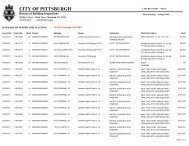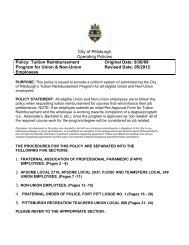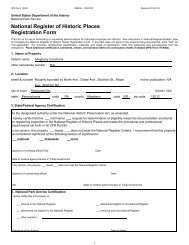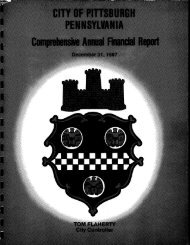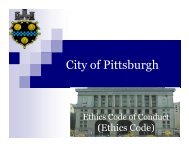east liberty station: realizing the potential - City of Pittsburgh
east liberty station: realizing the potential - City of Pittsburgh
east liberty station: realizing the potential - City of Pittsburgh
Create successful ePaper yourself
Turn your PDF publications into a flip-book with our unique Google optimized e-Paper software.
98<br />
Under a district-wide strategy, improvements<br />
financed would most likely facilitate fur<strong>the</strong>r<br />
development that would create new<br />
incremental revenue. The amount available<br />
to a value capture fund would increase and<br />
allow additional district-wide or project<br />
specific improvements to be financed. This<br />
process would continue over <strong>the</strong> 20 year life<br />
<strong>of</strong> <strong>the</strong> TRID. Establishing a large value<br />
capture district, such as <strong>the</strong> full half-mile<br />
maximum radius, beyond current<br />
development opportunities would limit <strong>the</strong><br />
total amount <strong>of</strong> increment available for<br />
planning study recommended improvements<br />
and maintenance. For example,<br />
redevelopment <strong>of</strong> a site in year 10 would<br />
provide only 10 years <strong>of</strong> new increment<br />
dedicated to a value capture fund.<br />
As previously discussed, <strong>the</strong> recommended<br />
value capture area within <strong>the</strong> elTRID<br />
boundary would be expanded over time to<br />
accommodate redevelopment <strong>of</strong> key sites<br />
not currently within <strong>the</strong> known pipeline.<br />
Much <strong>of</strong> this <strong>potential</strong> development is<br />
dependent on key district-wide infrastructure<br />
that will allow for increased density. The<br />
expansion would respond to local market<br />
conditions and provide <strong>the</strong> greatest degree<br />
<strong>of</strong> flexibility in terms <strong>of</strong> implementing <strong>the</strong><br />
development, transit and infrastructure<br />
recommendations in this planning study.<br />
Proposed value capture area expansions<br />
are based upon maximizing <strong>the</strong> <strong>potential</strong><br />
value capture to fund <strong>the</strong>se improvements.<br />
The recommended elTRID value capture<br />
strategy will guide investment in project<br />
specific infrastructure, district-wide<br />
improvements and maintenance.<br />
Approximately $65 million <strong>of</strong> incremental<br />
revenues would be generated by new<br />
projects within <strong>the</strong> TRID Boundary over 30<br />
years by phasing <strong>the</strong> value capture areas.<br />
Implementing <strong>the</strong> full boundary today would<br />
result in significantly less TRID proceeds<br />
available for <strong>the</strong> recommended projects.<br />
Nearly $17 million <strong>of</strong> available increment<br />
would be generated after year 20 and not<br />
captured if <strong>the</strong> value capture area was<br />
coterminous with <strong>the</strong> TRID boundary. This<br />
amount would most likely be even larger as<br />
<strong>the</strong> redevelopment <strong>potential</strong> <strong>of</strong> several sites<br />
not included in <strong>the</strong> analysis above increase<br />
after significant future district-wide<br />
improvements, such as completion <strong>of</strong> <strong>the</strong><br />
Penn Circle Two-Way conversion, are<br />
completed. However, fur<strong>the</strong>r revitalization<br />
efforts dependent upon this infrastructure<br />
would be limited without additional<br />
investment from <strong>the</strong> additional TRID<br />
proceeds realized only under <strong>the</strong> phased<br />
strategy.<br />
The recommended elTRID value capture<br />
strategy combines elements <strong>of</strong> <strong>the</strong> project<br />
specific and district-wide approaches to<br />
provide a means for key investments that<br />
will facilitate TOD within <strong>the</strong> study area. To<br />
<strong>the</strong> extent possible, <strong>the</strong> strategy provides for<br />
upfront funding for larger projects to<br />
overcome challenges inherent in <strong>the</strong>se<br />
urban, mixed-use developments. O<strong>the</strong>r<br />
redevelopment projects will contribute to <strong>the</strong><br />
newly created elTRID value capture fund<br />
(VC Fund) which will be utilized primarily to<br />
fund district-wide improvements. A guiding<br />
principal <strong>of</strong> <strong>the</strong> strategy will be to<br />
incentivize, not subsidize, TOD and<br />
infrastructure development within <strong>the</strong><br />
study area. Investments will be<br />
prioritized by <strong>the</strong>ir ability to facilitate<br />
fur<strong>the</strong>r redevelopment. Like with <strong>the</strong><br />
local TIF program, <strong>the</strong> ‘but-for’ test<br />
should apply where projects should only<br />
seek assistance if <strong>the</strong>y cannot proceed<br />
without a TRID investment.<br />
Sections below detail an example <strong>of</strong><br />
how <strong>the</strong> value capture strategy could be<br />
implemented for both projects in <strong>the</strong><br />
immediate pipeline and those fur<strong>the</strong>r on<br />
<strong>the</strong> horizon. As with <strong>the</strong> boundaries <strong>of</strong><br />
<strong>the</strong> value capture area, <strong>the</strong> TRID<br />
Management Entity would be<br />
responsible for determining project<br />
financing structures and VC Fund<br />
investment priorities across <strong>the</strong> district.<br />
The strategy would remain flexible to<br />
accommodate various future scenarios,<br />
but maintain <strong>the</strong> ability to provide<br />
assistance to large scale<br />
redevelopment projects as well as<br />
improvements that benefit multiple<br />
users.<br />
Phase I Strategy<br />
As detailed earlier, <strong>the</strong> proposed<br />
Phase I value capture area within <strong>the</strong><br />
elTRID Boundary contains several<br />
major redevelopment projects<br />
expected to commence within <strong>the</strong> next<br />
5 years. One <strong>of</strong> <strong>the</strong> most significant is<br />
<strong>the</strong> proposed expansion <strong>of</strong> Eastside in<br />
conjunction with reconstruction <strong>of</strong> <strong>the</strong><br />
East Busway <strong>station</strong>. Site<br />
development and necessary public



